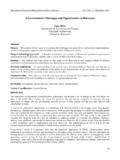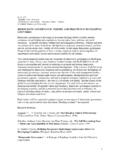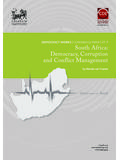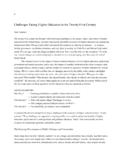Transcription of Problems and Challenges of Forest Governance in Georgia
1 Problems and Challenges of Forest Governance in Georgia TBILISI, 2012. The Embassy in Georgia The publication prepared by Association Green Alternative, within the project Transparent and Participatory Forestry Sector in Georgia funded through democracy Commission Small Grants Program, the Embassy in Georgia . The views expressed in this publication are those of the authors and should not be taken to represent those of the Embassy in Georgia This publication may be copied for non-commercial use, subject to the source being acknowledged. Author: Irakli Matcharashvili Edited by: Nino Gujaraidze Citation: I. Matcharashvili 2012. Problems and Challenges of Forest Governance in Georgia , Tbilisi, Association Green Alternative, 38 p. Tbilisi, 2012. INTRODUCTION. Since its foundation Green Alternative has been working on a problem related to the Forest sector in Georgia . Starting from 2000 the organization has been monitoring the elaboration and implementation process of 1.
2 World Bank Georgia Forests Development Project . Several reports were published in recent years with detailed review of the developments in this sector, the assessment and recommendations on conservation and sustainable management of forests. The situation in Forest sector changes so often and is so unpredictable that, for the sake of completeness, we deem it worthwhile to recall the main issues, raised in those reports. The organization's report titled Problems of Forestry Sector of Georgia : Illegal Activities and Legislative 2. Collisions contains 2005-2006 monitoring results. The study reviews facts of corruption and illegal actions in Forest sector and conducive to them factors; Problems of decision-making transparency, weak enforcement of the law; Problems of newly set up Environmental Inspection in fighting against illegal logging and possible corruption in this agency; possible corrupt deals at customs for timber export; materials of the journalistic investigation into the supply of firewood in Tbilisi; 2006 legislative chaos that followed the government's reckless actions related to providing rural population with firewood; separate chapter is dedicated to violations related to issuance of permits on felling in Imereti region the type of chestnut, listed in the Red Book; besides, the report contains the information on the extent of illegal logging on Kolkheti National Park territory.
3 3. In the same period a study titled Analysis and Recommendations Regarding Forest Legislation in Georgia . was published. It reviews the Forest legislation and institutional structure; factors, conducive to corruption, emerging from legal reform of that period. It also contains recommendation for eliminating the Problems analyzed in the study. 4. In the end of 2008 Green Alternative published its report on Monitoring Georgian Forest Sector . Chapter 1. of the report describes chronologically important developments, related to Georgia 's Forest sector in 2007- 2008; in subsequent chapters these developments are analyzed: the process of reforming Forest sector in Georgia and elaboration of policy/strategic documents, related to it since 2004 is described, thus demonstrating inconsistency of this process; also described are: unsuccessful attempt of decentralization of Forest sector, causes and results of this failure of Georgian government; Problems of rural population's access to Forest resources; continuation of the history of illegal issuance of permits for felling chestnut; violations and other Problems that accompanied the commercial Forest use in that period (issuance both, one year and long- term licenses).
4 The study provides recommendations with regard to the development of Forest sector in Georgia and describes in short the results of Green Alternative's advocacy and successful stories. Besides, several studies have been published on Forest conservation and sustainable management, including: 5. 2006 - Environmental Governance and forestry of Georgia ;. 6. 2007 Protection and management of biodiversity in: Georgia ;. 1. Georgia Forests Development Project 2. Problems of Forestry Sector of Georgia : Illegal Activities and Legislative Collisions, 2006, Tbilisi, Green alternative, 46 p. 3. Analysis and Recommendations Regarding Forest Legislation in Georgia , 2006, edited by I. Macharashvili, Association Green Alternative Tbilisi, 84 p. (in Georgian). 4. I. Matcharashvili, 2008. Monitoring of Georgian Forest Sector 2007-2008, Green Alternative, Tbilisi, 56 p. (in Georgian). 5. In: Environmental Governance in Georgia and how the EU can contribute to its strengthening , 2006, Green Alternative, 7.
5 2008 Decentralization of Forest Sector - manual ;. 8. 2009 Forestry sector in Georgia , policy brief ;. 2010 Policy Brief - Does the Georgian Legislation Provide the Protection and Sustainable Use of 9. Biodiversity? ;. 2011 Implementation of Convention on Access to Information, Public Participation in Decision- Making and Access to Justice in Environmental Matters (Aarhus Convention) In Georgia - Alternative 10. Report ;. 2012 Policy, institutional and regulatory gap analysis in the area of biodiversity protection and use 11. of biological resources . With present publication Green Alternative continues reporting on monitoring of Forest sector. Special emphasis is on the flaws in Georgian legislation in terms of transparency of Forest management and public participation in decision-making process. 6. I. Matcharashvili, 2007, Protection and management in Georgia , Green Alternative, Tbilisi, (in Georgian). 7. I. Matcharashvili, 2008, Decentralization of Forest Sector Manual, Green Alternative, Tbilisi 8.
6 I. Matcharashvili, 2009, Forestry sector in Georgia , policy brief, Caucasus Institute for Peace, democracy and Development, Tbilisi, 6 p. ; 9. I. Matcharashvili, 2010. Policy Brief - Does the Georgian Legislation Provide the Protection and Sustainable Use of Biodiversity? Green Alternative, Tbilisi 10. Gurchiani T., K. Gujaraidze, 2011 Implementation of Convention on Access to Information, Public Participation in Decision-Making and Access to Justice in Environmental Matters (Aarhus Convention) In Georgia - Alternative Report, Tbilisi, Green Alternative 11. Environmental policy, institutional and regulatory gap analysis, 2012, Green Alternative. 2. GENERAL OVERVIEW OF Forest Governance IN GEORGIA12. INSTITUTIONAL STRUCTURE. Before the establishment of Soviet regime forests belonged to the State, private owners, churches, villages and communities ( families and clans). After 1921 Forest was declared state property and Commissariat for Agriculture was made responsible.
7 During Soviet period the same law for Forest sector management was 13. adopted in all the union republics. In accordance to 1923 law Forest were divided into two groups: those managed by the State (urban, assigned and reserves) and local or collective farm forests. The lands under the kolkhoz forests were in permanent tenure of the collective farms and were registered in corresponding agencies as forests owned by collective farms. All regulations pertaining to Forest use, protection and restoration, provided by the Forest legislation, applied to the kolkhoz forests. Forestry was run by foresters, supervised and audited by Forest inspectors. This system was in force until the end of 20-ies and 5 December 1929 the Resolution on Soviet forestry ( leskhoz ). and Soviet industrial forestry ( lespromkhoz ) was adopted. In 1930 the forestry and Forest industry were united into union Association Soviet Forest industry . ( Sojuzlesprom ) and new period of absorbing forestry by industry started wide-scale use of forests for industrial purposes replaced sustainable use of forests.
8 31 July 1931 Forest areas were split into two zones: forestry and Forest plantations. These two zones were run by two different government bodies. In 1939 special government agencies for Forest protection were set up. Even during Second World War government agencies for Forest protection and monitoring were being created. In 1947 Union Ministry for Forestry, independent body for Forest management was established. But in 1953 it was abolished and subordinated to Ministry of Agriculture. But Ministry of Agriculture failed to manage forests and 6 years later the agency in charge of forests was separated from the Ministry. In 1977 The Foundations of Forest legislation of the Soviet Union was approved, on the basis of which, one year later, all union republics passed their own Forest Codes. In 1978 Forest Code of Georgian SSR entered in force and all the forests on Georgia 's territory were managed in compliance with it. In accordance with the Code all of the country's forests forests subordinate to Forest agencies, assigned forests, forests belonging to former collective farms and state farms, nature reserves - constitute a single state Forest fund.
9 In accordance to the Code forests of national importance and collective farm forests in Georgian SSR carried out only water- conservation, protection, hygienic and recreational functions and had minor operational functions. State management in the area of the use, reproduction, and care and protection of forests in Georgian SSR was carried out by Council of Ministers of the USSR, Council of Ministers of Georgian SSR, Councils of Ministers of Adjara and Abkhaz Autonomous Republics, Executive Committees of local Councils of People's Deputies, as well as forestry State bodies and other state agencies in compliance with legislations of the USSR and Georgian SSR. Care and protection, and reforestation in Georgia were carried out by State Forestry Department. Forest use was allowed only under special permit logging ticket or Forest ticket of a special form, which was approved by USSR Council of Ministers in accordance with established procedure.
10 Logging tickets or Forest tickets were issued by organizations and agencies in charge of forestry. State control over the state, use, reproduction, care 12. As of 15 September 2012. 13. Forests nationalization in Russia took place before Georgia 's annexation: 27 May 1918 Central Executive Committee's Decree on forests was passed, under which private ownership of forests, buildings and equipment of forestry was banned. 3. and protection of collective farm forests were carried out by Councils of People's Deputies, their executive and administrative bodies, as well as forestry State bodies and other authorized bodies in compliance with established procedure. Forests on the lands transferred to collective farms in perpetuity that were properly registered in land records, were considered to belong to collective farms and the later possessed them perpetually too. In accordance with the basics of the USSR and Union Republics' Forest law these forests were managed by collective farms in compliance with the Regulations on collective farm forests, approved by the USSR Council of Ministers.






